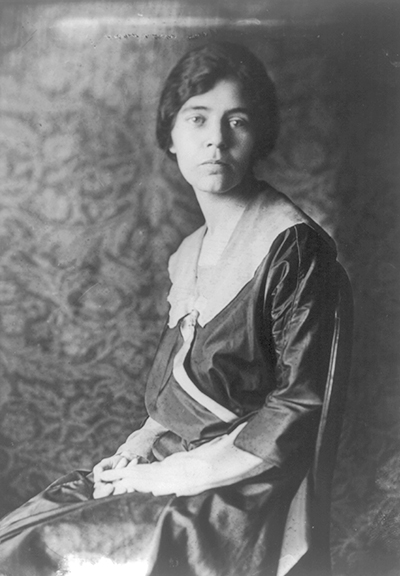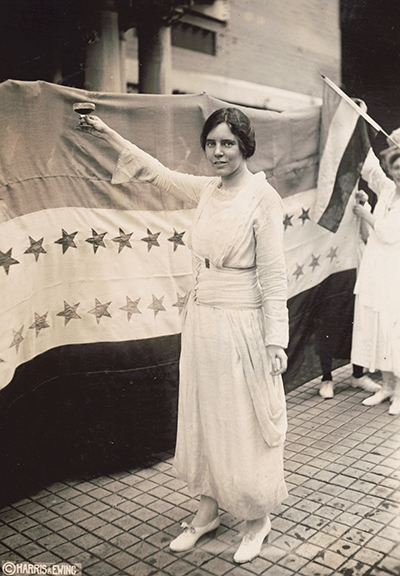"Men and Women Shall Have Equal Rights": Alice Paul and the Suffrage Movement
by Mary Walton
 Born in 1885 to devout New Jersey Quakers William and Tacie Paul, Alice Paul was steeped in the belief that everyone is equal in the eyes of God. The oldest of four, Alice attended Quaker schools and was valedictorian of her class at Swarthmore, a coed Quaker college in Pennsylvania. Endowed with a love of learning, she earned a master’s degree at the University of Pennsylvania, then enrolled in a school of social work in New York while living and working in a settlement house on the Lower East Side. In 1907 she spent a year in England at a Quaker study center. Arriving in Berlin, she studied German, which would be an asset in the academic career she hoped to have.
Born in 1885 to devout New Jersey Quakers William and Tacie Paul, Alice Paul was steeped in the belief that everyone is equal in the eyes of God. The oldest of four, Alice attended Quaker schools and was valedictorian of her class at Swarthmore, a coed Quaker college in Pennsylvania. Endowed with a love of learning, she earned a master’s degree at the University of Pennsylvania, then enrolled in a school of social work in New York while living and working in a settlement house on the Lower East Side. In 1907 she spent a year in England at a Quaker study center. Arriving in Berlin, she studied German, which would be an asset in the academic career she hoped to have.
A dutiful correspondent, Paul wrote her mother of new friends, the joys of cycling, and fireside chats with classmates. In 1908 she enrolled in the London School of Economics. She also joined the Women’s Social and Political Union headed by the militant suffragist Emmeline Pankhurst. The WSPU’s motto was “Deeds, Not Words.”
Later in life Paul would tell oral historian Amelia Fry that she became a “heart and soul convert” to the suffrage cause after hearing a rousing speech by Pankhurst’s daughter Christabel.[1] In Quaker parlance, she had found her “concern,” a spiritually inspired obligatory call to action. Equal rights for women would become Paul’s lifelong mission.
Despite her heritage, however, Paul confessed to Fry that in her youth she knew Quaker activist Lucretia Mott only as a portrait at Swarthmore. Nor was she familiar with Elizabeth Cady Stanton, whom Mott encouraged to organize the convention that gave rise to the trailblazing 1848 Declaration of Sentiments, which adopted the language of the Declaration of Independence to assert that women deserved equal rights: “We hold these truths to be self-evident: that all men and women are created equal.”
Alice and her mother had attended Quaker suffrage meetings, and Tacie was likely proud of her daughter’s commitment. In 1909, however, Alice’s letters from England took a troubling turn. She was arrested repeatedly in protests, seven times that year. Denied the privileges of male political prisoners, the Pankhurst acolytes began hunger strikes. Authorities resorted to forced feeding. Paul wrote that four people held her down as a doctor threaded a tube through her nose and poured liquid food down a funnel. The process was “exceedingly painful . . . I never went through it without the tears streaming down my face.”[2]
When Paul was arrested for disrupting a political banquet, news of the “young woman from Philadelphia” made the New York Times.[3] A Times reporter turned up at her childhood home. “I cannot understand how all this came about,” Tacie Paul told him. “Alice is such a mild-mannered girl.”[4]
Paul returned to America in 1910, and enrolled in the doctoral program at Penn. But suffrage beckoned. She led Philadelphia’s first street campaign for a suffrage amendment to the state constitution. In 1912 women could vote in only eight states, all out west.
That year, the National American Woman’s Suffrage Association approved Paul’s proposal to run its moribund congressional committee and seek a federal suffrage amendment. It also endorsed her plan for Washington’s first suffrage parade the day before the inauguration of Woodrow Wilson, a staunchly anti-suffrage southern Democrat.
On March 3, 1913, dozens of elaborate floats and 8,000 marchers set out from the Capitol. A banner announced the goal: “We demand an amendment to the Constitution of the United States enfranchising the women of the country.”
Thousands of spectators lined Pennsylvania Avenue. Arriving at the train station that morning, Wilson was disappointed by the sparse welcoming crowd. “Where are all the people?” he is said to have asked. The reply: “On the Avenue watching the parade.”[5]
As hundreds of combative, often drunk male onlookers spilled into its path, the parade slowed to a trickle. A US Cavalry troop was summoned to clear the way. Surprisingly, Paul was delighted. She was sure the publicity would command headlines and bring a quick victory for the cause. She was wrong.
Over the next four years feminist pressure failed to budge Wilson from his position that suffrage was a state issue. Nor did demonstrations, stunts, and lobbying sway the Democratic majority in Congress, many of them southerners fearful of Black women casting votes.
On January 9, 1917, the leaders of Paul’s fledgling National Woman’s Party debated the future. Her ally, Harriot Stanton Blatch, Elizabeth Cady Stanton’s daughter, voiced their frustration. “We can’t organize bigger and more influential deputations. We can’t organize bigger processions. . . . We have got to take a new departure.”[6]
The next morning, a dozen pickets under Paul’s command flanked the White House gates. Bundled up against the fierce cold, they struggled to hold aloft silk banners as long as the women were tall. The messages challenged Wilson, “Mr. President, How Long Must Women Wait for Liberty?” and “Mr. President, What Will You Do for Woman Suffrage?”
Returning from his daily game of golf, Wilson passed through the gate. Stony faced, he looked neither right nor left.
The United States had just entered World War I. Mobs formed, and men in uniform attacked “the traitors.” The media was hostile. Even Tacie Paul scolded her daughter for annoying the President. Arrested and convicted of “obstructing traffic,” scores of demonstrators were jailed. Paul activated the Pankhurst playbook. Refusing food, they were force fed.
!["When Tennessee, the 36th state, ratified [the Nineteenth Amendment] on Aug 18, 1920, Alice Paul, national chairman of the Woman's Party, unfurled the ratification banner from suffrage headquarters, Washington, DC," photograph by Harris & Ewing, 1920 (Library of Congress)](/sites/default/files/2025-03/AlicePaul_Banner_LOC.jpg) In some ways the war helped. Women had replaced men in the workforce. Were they not worthy of suffrage? Wilson’s international reputation as a peacemaker was at stake. Moreover, the number of suffrage states and women voters had multiplied, worrying anti-suffrage legislators. On September 30, 1918, Wilson endorsed the federal amendment, labeling it “a vital wartime measure.” But not until August 26, 1920, after Congress approved and thirty-six states ratified, was it signed into law.
In some ways the war helped. Women had replaced men in the workforce. Were they not worthy of suffrage? Wilson’s international reputation as a peacemaker was at stake. Moreover, the number of suffrage states and women voters had multiplied, worrying anti-suffrage legislators. On September 30, 1918, Wilson endorsed the federal amendment, labeling it “a vital wartime measure.” But not until August 26, 1920, after Congress approved and thirty-six states ratified, was it signed into law.
In 1921, the NWP celebrated the passage of the Nineteenth Amendment with the unveiling of a statue in the Capitol rotunda depicting feminist heroes Stanton, Mott, and Susan B. Anthony. It was whisked away by authorities, not to return until 1997.
Women could now cast ballots, but voting alone did not suffice. Paul enrolled in law school to prepare for the battle against legal discrimination.
Reality set in. She told Fry with a laugh, “You know, there [were] two pages of [Seneca Falls] resolutions. . . . Well, the people [in our suffrage campaign] had pretty nearly killed themselves, had no money left and no strength left.”[7]
 Was Paul being disingenuous? For months she had been working on the wording of a powerful constitutional amendment that would guarantee total equality.
Was Paul being disingenuous? For months she had been working on the wording of a powerful constitutional amendment that would guarantee total equality.
Paul introduced the Equal Rights Amendment in Seneca Falls on July 21, 1923. The Wesleyan Chapel, where Stanton had made history seventy-five years earlier, was now a tire repair garage. NWP members gathered instead at the nearby Presbyterian Church to hear Paul intone, “Men and women shall have equal rights throughout the United States and every place subject to its jurisdiction.”[8]
But Paul had not foreseen fears that equality with men would erase women’s hard-won protections in the workplace. Where once suffragists had to overcome a hostile president and Congress, working women, armed with the vote, banded together against the ERA. At congressional hearings, Paul and her followers were often the only ones to speak in favor. Power clearly could be a double-edged sword.
Alice Paul died on July 9, 1977, at the age of ninety-two, having lived to see the ERA pass Congress but fail ratification.
Mary Walton is a former reporter for the Philadelphia Inquirer and a contributor to the New York Times, Washingtonian, the Washington Monthly, the American Journalism Review, and PBS. She is the author of A Woman’s Crusade: Alice Paul and the Battle for the Ballot (Palgrave Macmillan, 2010).
[1] Alice Paul, quoted in Amelia R. Fry, Conversations with Alice Paul: Woman Suffrage and the Equal Rights Amendment, Suffragists Oral History Project, The Bancroft Library, University of California, Berkeley, 1976, 33–34.
[2] Alice Paul to Tacie Paul, June 5, 1909, Alice Paul Papers, Arthur and Elizabeth Schlesinger Library on the History of Women in America (hereafter APP), Radcliffe Institute for Advanced Study, Harvard University, Cambridge, MA, box 1: folder 14.
[3]New York Times, November 12, 1909, p. 1.
[4]New York Times, November 13, 1909, p. 6.
[5] Doris Stevens, Jailed for Freedom (New York: Boni and Liveright, 1920; repr. New York: Schocken Books, 1976), p. 21.
[6] Harriot Stanton Blatch and Alma Lutz, Challenging Years: The Memoirs of Harriot Stanton Blatch (New York: G. P. Putnam’s Sons, 1940), p. 276.
[7] Alice Paul, quoted in Amelia R. Fry, Conversations with Alice Paul, p. 187.
[8] In 1943 Paul wrote the revised version we know today: “Equality of rights under the law shall not be denied or abridged by the United States or by any State on account of sex.”









































































